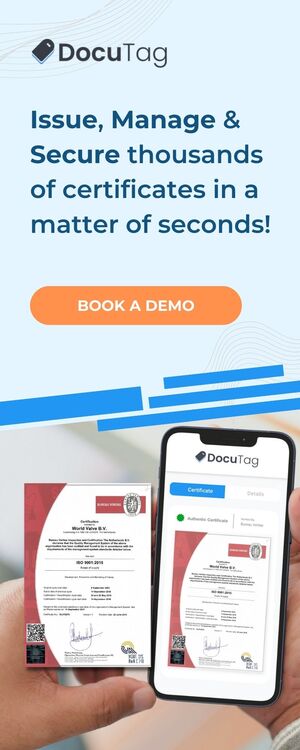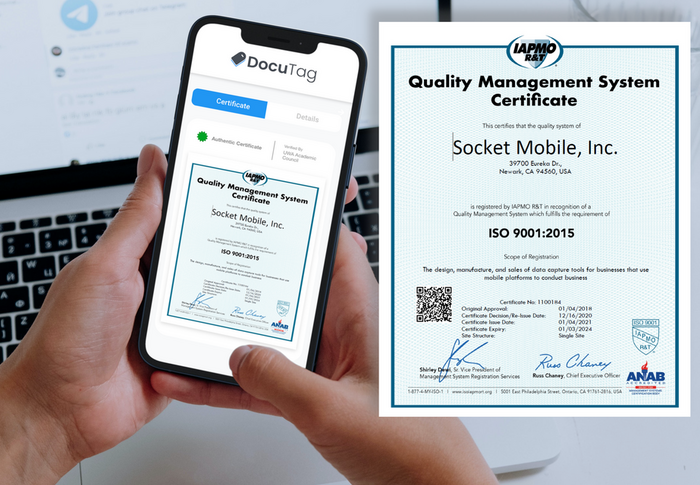In a simple definition, a certificate is a designated official document recognized by authorities that an individual or a business entity earns upon completing a certification that attests to a status, a claim, or a level of achievement or proficiency.
For the longest time, Certificates have always been associated with a physical form, a paper-based document. However, that is rapidly changing, with digital certificates taking over the credential scene.
So, What is a digital certificate?
A digital certificate, also known in the technical world as a verifiable credential (VC), is:
1) An electronic representation of a physical certificate such as a passport, birth certificate, license, university degree, etc.
2) An electronic certificate representing information with no physical equivalent, such as a bank account ownership.
All information on the e-certificate is branded digitally, from the organization’s logo to the issuer’s signature.
The e-certificates usually contain the same information as the traditional ones, but it also provides the flexibility for additional Data, evidence, embedding, and sharing that the former lacks.
In short, it’s the evolution of certificates.
What is the issue with physical certificates?
Here are six issues that emphasises the shortcomings of physical credentials and why many organizations are switching and deploying digital certificates:
- #1: High costs
One of the main drawbacks of Paper-based documents is the high cost of creating and managing its system. Having professional, high-quality printing and reliable mail delivery is already expensive. Adding up the extra cost from amendments, recertification, and lost mail can make it a significant outlay for organizations that might exceed five figures.
- #2: Lack of storage space
Without a doubt, paper documents take up a significant storage space, which might become a severe issue in the long run as the certificates’ volume keeps increasing. Not to forget that these certificates must be stored close by to be accessible at all times.
- #3: Security and Damage Risks
The issue with Physical certificates is that they aren’t optimal in terms of Data protection, which is crucial for all types of businesses. Physical credentials can easily be lost, damaged, mishandled, stolen or misplaced.
If you don’t have copies of the files, there is no way of getting the information back.
- #4: Editing and transportation
When editing a paper-based certificate, the issuer must redo the whole slow and lengthy process of creating it the first time, even if it’s a minor change, which is neither time, effort, nor cost-effective.
In addition, transporting certificates in a paper-based system is equally complicated and inefficient.
- #5: Not environment friendly
It’s no secret that paper is bad for the environment. It is the third largest industrial polluter of air, water, and land, with environmental activists wreaking havoc on organizations that worsen the pollution. The less you use it, the more you get to boost your company’s green credentials and sustainability points.
How digital certificates do it better?
- Time-saving
Time is your most valuable asset, and switching to digital certificates will save up to 90% of the time spent on the traditional certificate-creating process and all the responsibilities that come with it.
- Minimal overheads
Switching to digital certificates will allow you to save a large amount of money as it reduces your certification costs drastically; no more costs of printing, storing, mailing or manually managing and verifying the credentials. The only cost that e-certificates compromises are the subscription fees of the platform that will assist you with digital certificate management.
- Secure and Verifiable
Most Digital credentials are based on blockchain technology, which renders them 100% secure, tamper-proof, verifiable, and permanent. You get to encrypt your digital certificates and safely store them as blockchain information that is impossible to falsify.
In addition, Digital certificates simplify the verification process for issuers, recipients and any involved partakers. The only step needed for the verification is to scan the QR code that the certificate compromises.
- Instant delivery and distribution
By Digitizing your certificates, you can eliminate all the frustration caused by mail delays or any transportation problems that might occur, such as tampering, theft, or loss in transit, since the digital delivery is instant and free of cost no matter where the receiver’s location is.
- Data storage and other Conveniences
Adopting a digital certificate management system will noticeably increase the effectiveness of your operations and productivity, breaking you away from the slow and outdated certificate management process.
Unlike physical certificates, digital certificates are way more convenient in terms of:
- Accessibility: Certificates are saved as digital files that can easily be stored and accessed anytime on your computer or phone.
- Locating files: No extra time is wasted manually finding a file; a simple keyword is enough.
- Editing: You can edit and update your digital certificates anytime with a simple click.
- Sharing: You have options to mail, share certificates to different apps and even post on social media sites if you choose the right management platform.
- Saving the environment
The digitization of certificates can help businesses reduce their carbon footprint and paper waste. Which positively portrays you as a sustainable business and attracts customers who prioritize sustainability and prefer environmentally friendly alternatives
How to start with Digital certificates?

The easiest way to employ digital credentials and cultivate their benefits is by choosing the right certificate management solution for your organisation.
DocuTag is a Blockchain-Powered Certificate Management System, It’s an affordable, simple-to-use solution for organizations that are looking to digitize their certification process efficiently and secure their certificates ‘ authenticity.






